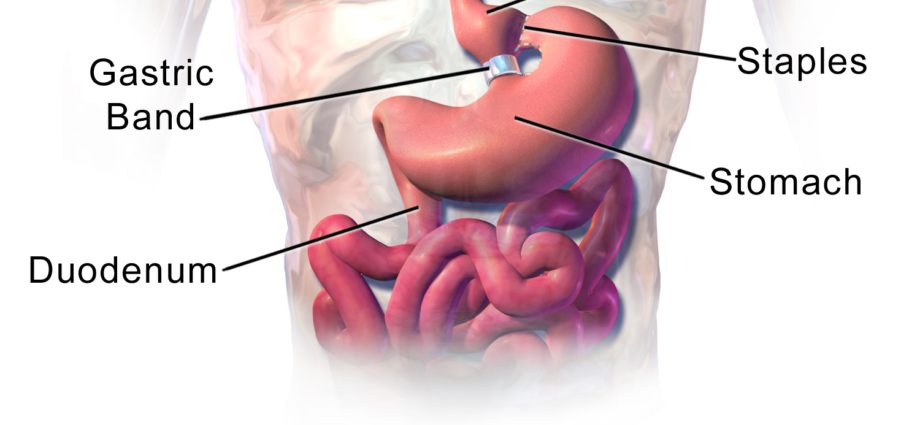Contents
Gastroplasty
The installation of a gastric band is a reversible operation of obesity surgery (gastroplasty) which aims to reduce the size of the stomach. It is generally performed by laparoscopy. The expected weight loss can be in the range of 40-60% of excess weight. To increase the chances of success, the placement of a gastric band must be associated with post-operative follow-up by the surgical team and compliance with certain rules by the patient, in particular regarding diet.
What is gastroplasty?
Gastroplasty is an obesity surgery that aims to reduce the size of the stomach. It makes it possible to reduce the quantity of food ingested by causing a feeling of early satiety which helps patients to modify their eating habits as part of a comprehensive and long-term management of their obesity.
Gastric band
A gastroplasty ring is placed around the upper part of the stomach to delimit a small pocket. This small stomach fills up quickly during feeding, resulting in early satiety. Then, this small pocket slowly empties into the part of the stomach located below the ring and then digestion takes place normally. This ring is connected by a small tube to a control box placed under the skin. This ring can be tightened or loosened by injecting a liquid into the case, through the skin. Placing a gastric band is the only fully reversible obesity surgery.
Other types of gastroplasty
- The gastric bypass is a technique which combines the construction of a small pocket in the upper part of the stomach which causes a significant decrease in gastric capacity, and a short-circuit of part of the intestine to limit the quantity foods assimilated by the body
- The sleeve gastrectomy (or sleeve gastrectomy) consists in removing approximately 2/3 of the stomach, and in particular the part containing the cells which secrete the hormone stimulating the appetite (ghrelin). The stomach is reduced to a vertical tube, and food passes quickly through the intestine.
How is the placement of a gastric band performed?
Preparing for the placement of a gastric band
The operation must be preceded by a complete assessment which also allows the patient to have time to think before proceeding to the surgical act.
The day of the exam
The patient enters the hospital the day before (or the morning) of the operation.
The intervention
The operation is usually performed laparoscopically with the help of a camera through small incisions ranging from 5 to 15 mm. In rare cases, it can be done through a classic incision (laparotomy). The operation takes place under general anesthesia, and it can last up to 3 hours.
Why have a gastric band fitted?
Like all gastroplasty operations, the placement of a gastric band can be considered in people:
- With a body mass index (BMI) greater than or equal to 40
- With a BMI greater than or equal to 35 who have serious weight-related health problems (diabetes, high blood pressure, sleep apnea, heart failure)
Expected results / The days following the operation
The expected results
Excess weight corresponds to the number of extra pounds compared to an expected ideal weight calculated on the basis of a BMI between 23 and 25. After fitting a gastric band, the expected weight loss as a percentage of l he excess weight is 40-60%. This corresponds to a weight loss of about 20 to 30 kg for a person of average height (1m70) with a BMI equal to 40.
Possible complications
The placement of a gastric band requires careful monitoring by the surgical team after the operation. The average hospital stay is around 3 days, it allows the medical team to take charge of any post-operative complications (infections, hemorrhages, etc.) Obesity increases the risk of phlebitis (clot in the veins ) and pulmonary embolism. In this case, injections to thin the blood and compression stockings can be considered after the operation.
Later mechanical complications can also occur:
- Problems related to the case: infections, displacement of the case under the skin, pain at the location of the case, rupture of the tube connecting the case and the ring;
- Sliding of the ring and dilation of the pouch above the ring which can lead to severe vomiting or even the inability to eat;
- Esophageal disorders (reflux, esophagitis);
- Stomach lesions caused by the ring (erosion of the stomach, migration of the ring).
The aftermath of the intervention
- The patient should consult his surgeon and nutritionist for prolonged follow-up. He must respect dietary advice: eat semi-liquid then solid, eat slowly, do not drink while eating, chew solids well.
- After returning home, the patient should monitor the occurrence of certain symptoms (shortness of breath, abdominal pain, fever, bleeding from the anus, repeated vomiting or shoulder pain) and contact his surgeon if one of them occurs. . Even late after the operation, repeated vomiting should be reported to his doctor.
- As with any obesity surgery, pregnancy is not recommended during the first postoperative year.










